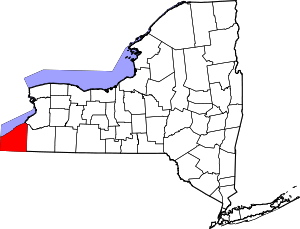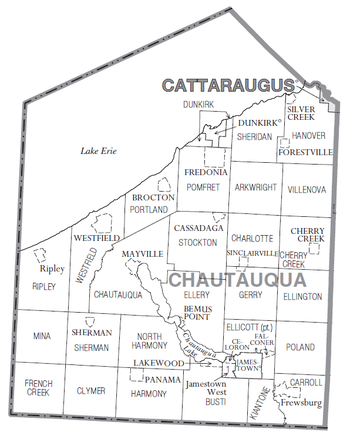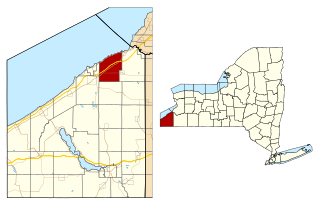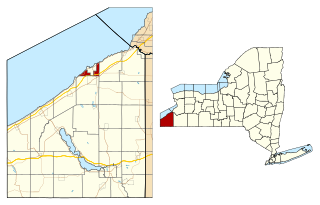Chautauqua County | |
|---|---|
 Chautauqua County Courthouse in Mayville | |
 Location within the U.S. state of New York | |
 New York's location within the U.S. | |
| Coordinates: 42°18′N79°25′W / 42.3°N 79.41°W | |
| Country | |
| State | |
| Founded | February 9, 1811 |
| Named for | Chautauqua Lake |
| Seat | Mayville |
| Largest city | Jamestown |
| Area | |
| • Total | 1,500 sq mi (4,000 km2) |
| • Land | 1,060 sq mi (2,700 km2) |
| • Water | 440 sq mi (1,100 km2) 29% |
| Population (2020) | |
| • Total | 127,657 [1] |
| • Density | 120.4/sq mi (46.5/km2) |
| Time zone | UTC−5 (Eastern) |
| • Summer (DST) | UTC−4 (EDT) |
| Congressional district | 23rd |
| Website | chqgov |
Chautauqua County is the westernmost county in the U.S. state of New York. As of the 2020 census, the population was 127,657. [2] Its county seat is Mayville, [3] and its largest city is Jamestown. Its name is believed to be the lone surviving remnant of the Erie language, a tongue lost in the 17th century Beaver Wars; its meaning is unknown and a subject of speculation. The county was created in 1808 and organized in 1811. [4] The county is part of the Western New York region of the state.
Contents
- History
- Geography
- Adjacent counties
- Major highways
- Demographics
- 2020 Census
- 2000 Census
- Government and politics
- New York State Assembly
- Education
- Communities
- Towns
- Other hamlets
- Indian reservation
- Unorganized territory
- In literature
- See also
- Notes
- Citations
- Further reading
- External links
Chautauqua County comprises the Jamestown–Dunkirk–Fredonia, NY Micropolitan Statistical Area. It is located south of Lake Erie and includes a small portion of the Cattaraugus Reservation of the Seneca.




















